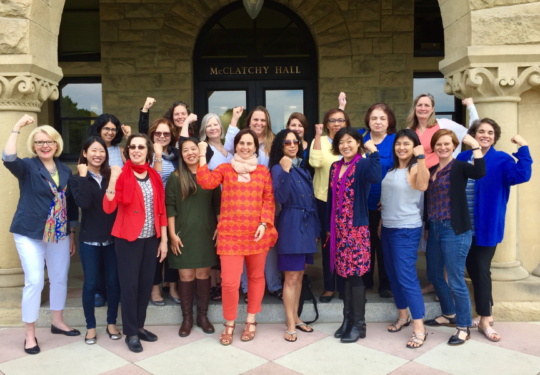Journalism Women Stand ‘With People of Color’
Journalists Struggle in Underreported Sudan War
Andrea Ford Fought to Stay on the O.J. Story
Journalists Hit in Gaza Refugee Camp, Hospital
Haitian Journalists Want Protection Under Any Deal
Palestinian Photographer Takes ‘Photo of the Year’
Short Takes: Dion Rabouin; Tamron Hall; Mariel Garza; South Florida NABJ-NAHJ career fair; LGBTQIA+ representation in TV and viewership; Chips Quinn program; LA Taco; Knight-Bagehot fellows; D. Watkins and Vernon Jarrett Medal; rights of student journalists; Editor & Publisher’s new public media vertical; Amara Omeokwe; Indira Lakshmanan; Estrella Media; Wilbert Rideau;
Katie Couric and Bryant Gumbel; press freedom in India; South Africa’s reversal of criminal defamation law; Mali’s ban on political reporting; Nigeria’s ace investigative reporter; Togo arrests one journalist; frees another; Hong Kong expels Reporters Without Borders rep.
Homepage photo: Journalism & Women Symposium (JAWS) by Nina Zocuto
Support Journal-ismsDonations are tax-deductible.
Updated April 19

The Journalism & Women Symposium says it is “in its 38th year of advancing the professional empowerment and personal growth of women in journalism and advocating for more inclusive coverage of the diverse experiences and cultures that comprise our society. We believe that by advancing women in journalism, we transform the world.”
Journalism Women Stand ‘With People of Color’
- Also: Ready to Call Out Backsliders on DEI (April 22)
As forces against diversity, equity and inclusion make alarming gains in the courts, state legislatures, business and academia, the nation’s pre-eminent organization of women in journalism says it “stands with people of color in combating anti-DEI misinformation, especially as it affects women journalists of color.”
Angela Greiling Keane, president of the 38-year-old Journalism & Women Symposium, known as JAWS, made the statement in response to a question from Journal-isms about a challenge from Marc Morial, president and CEO of the National Urban League, for women and non-Black people of color to join African Americans in countering the anti-DEI offensive.
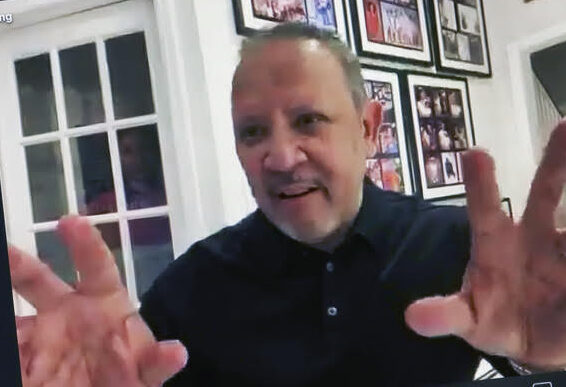 Morial (pictured, by Sharon Farmer) made his comments at an April 11 Journal-isms Roundtable on how to counter the efforts against DEI. He is part of an “unofficial coalition of civil rights, political and advocacy groups” who “are launching a multifaceted counter to the growing cries to dismantle diversity, equity and inclusion efforts stoked by billionaires like Elon Musk and Bill Ackman, among others,” as Curtis Bunn reported in February for NBC News.
Morial (pictured, by Sharon Farmer) made his comments at an April 11 Journal-isms Roundtable on how to counter the efforts against DEI. He is part of an “unofficial coalition of civil rights, political and advocacy groups” who “are launching a multifaceted counter to the growing cries to dismantle diversity, equity and inclusion efforts stoked by billionaires like Elon Musk and Bill Ackman, among others,” as Curtis Bunn reported in February for NBC News.
At the Roundtable, Morial offered “a suggestion that we all must step up in the lanes in which we work at this time to push back on this assault, because it is indeed an assault.
“Now here’s the truth. . . . D E and I and the Civil Rights Act of ’64 banned discrimination based on race, gender, religion and national origin.
“The work to get that change was the work of activism and litigation for decades.
“However, others who benefited from quote equal economic opportunity in D E and I have been too quiet.
“Our friends in other communities of color.
“Our friends who were on the front lines of the women’s movement.
“They’ve got to recognize that this attack . . . the point is on Black people, the broad attack is on inclusionary policies of the last 70 years.
“So this is an important discussion. Journalists, you always have power.”
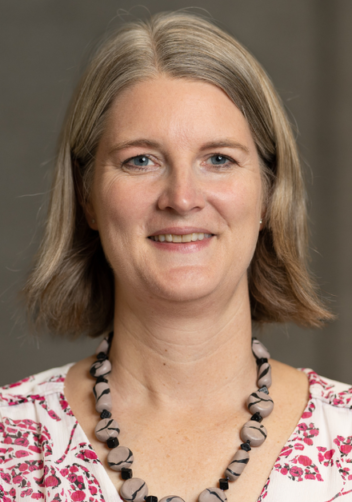 JAWS President Keane (pictured) responded, “JAWS stands with people of color in combating anti-DEI misinformation, especially as it affects women journalists of color. JAWS has worked to embed that commitment in everything we do via our DEI strategy that centers our mission.
JAWS President Keane (pictured) responded, “JAWS stands with people of color in combating anti-DEI misinformation, especially as it affects women journalists of color. JAWS has worked to embed that commitment in everything we do via our DEI strategy that centers our mission.
“Women in journalism today stand on the shoulders of those before us who fought for gender equity in the news industry.
“It is absolutely incumbent upon us to speak about this — both about how lawsuits got equal access to newsroom jobs and later to more equal pay. But many women of all ages – myself included — have stories about gender inequities or gender-based harassment we’ve experienced in the workplace and professional situations. And this is magnified for women of color.
“It is important for individuals to talk about these things to shed light on problems that persist. Sunlight is an antidote, and knowing about discrimination, harassment and inequities is an important step to addressing them.”
The Chronicle of Higher Education reports that 80 anti-DEI bills have been proposed in 28 states.
One of the more outrageous canards was circulated last month after the Key Bridge collapse in Baltimore. MAGA supporters tagged Mayor Brandon Scott, who is African American, as “the DEI mayor.” Scott quipped in a later interview, with MSNBC’s Joy Reid, “What they mean by DEI, in my opinion, is Duly Elected Incumbent.”
Journal-isms reached out to the National Association of Hispanic Journalists, the Asian American Journalists Association and the Indigenous Journalists Association for comment, but these organizations did not immediately respond.
Ken Lemon, president of the National Association of Black Journalists, told the NABJ board of directors Feb. 3 that he was creating a “diversity audit,” in which NABJ members could report, even anonymously, “anything that limits Black folks.” He said NPR television critic Eric Deggans and Madison Carter, NABJ secretary and an anchor and investigative journalist at WSOC-TV in Charlotte, N.C., would do the monitoring.
However, two months later, the effort does not seem to be much beyond an idea. NABJ did not respond to a request for comment.
The Journal-isms Roundtable was attended by 58 people via Zoom, with 32 watching on Facebook and 94 viewing the YouTube recording, as of April 18.
A proposed class action lawsuit against the Gannett Co. by a white male journalist who claims “reverse discrimination” continues in federal court.
“No comment yet,” Lemon of NABJ messaged in November. “We are aware of the situation and are closely monitoring it.”
Writing for Vox in 2016, Victoria M. Massie told readers, ” ‘The primary beneficiaries of affirmative action have been Euro-American women,‘ wrote Columbia University law professor Kimberlé Crenshaw for the University of Michigan Law Review in 2006.
“A 1995 report by the California Senate Government Organization Committee found that white women held a majority of managerial jobs (57,250) compared with African Americans (10,500), Latinos (19,000), and Asian Americans (24,600) after the first two decades of affirmative action in the private sector. In 2015, a disproportionate representation of white women business owners set off concerns that New York state would not be able to bridge a racial gap among public contractors.
“A 1995 report by the Department of Labor found that 6 million women overall had advances at their job that would not have been possible without affirmative action. The percentage of women physicians tripled between 1970 and 2002, from 7.6 percent to 25.2 percent, and in 2009 women were receiving a majority of bachelor’s, master’s, and doctoral degrees, according to the American Association of University Women. To be clear, these numbers include women of all races; however, breaking down affirmative action beneficiaries by race and gender seems to be rare in reported data.
“Contrary to popular belief, affirmative action isn’t just black. It’s white, too. But affirmative action’s white female faces are rarely at the center of the conversation. . . .”
More about the April 11 Roundtable in the coming days. The session was attended by 58 people via Zoom, with 32 watching on Facebook and 94 viewing the YouTube recording, as of April 18.
- Char Adams, NBC: UT Austin students protest school’s DEI layoffs amid state ban
- Janice Gassam Asare, Forbes: Media Misogynoir: Analyzing The Treatment Of Black Women In Modern Media (April 7)
- Kevin Blackistone, Washington Post: Black college athletes can send a message to Ron DeSantis by staying away (March 11)
- Jamelle Bouie, New York Times: Elon Musk Is Preoccupied With Something He Doesn’t Understand (March 23)
- Grace Chai, Daily Collegian, University of Massachusetts: Why journalism needs diversity
- Acacia Coronado, Associated Press: Texas’ diversity, equity and inclusion ban has led to more than 100 job cuts at state universities
- Joe Davidson, Washington Post: A colonel promoted diversity. So a GOP senator is blocking his promotion. (March 7)
- Heather Dunhill, Sarasota Magazine: Samantha Gholar on the Lack of Black Journalists in Newsrooms and the State of Diversity in Sarasota
- Ashleigh Fields, Washington Informer: Congress Votes to Dissolve House Office of Diversity and Inclusion (April 2)
- Mia Galuppo, Hollywood Reporter: After a Mass Exodus of Diversity Execs, What’s Next? (July 20, 2023)
- Suzanne Gamboa and Iris Kim, NBC: Bans on diversity, equity and inclusion may halt Latino progress in higher education (March 9)
- Sophie Gardner, Politico: What Women Have Gained From Affirmative Action (June 16, 2023)
- Mike and Emily Green, Common Ground Conversations Journal: The War on Black Women and DEI (April 8)
- Emil Guillermo, Asian American Legal Defense and Education Fund: The shattered mirror of mainstream journalism, Cesar Chavez Day, plus more “Emil Amok” (March 25)
- Katherine Itoh, NBC: George Floyd scholarship accused of discriminating against non-Black students in federal complaint (March 29)
- David A. Lieb, Associated Press: GOP state attorneys push back on Biden’s proposed diversity rules for apprenticeship programs (March 20)
- Mark Long, Associated Press: NAACP urges student-athletes to reconsider Florida colleges after state eliminates DEI programs (March 12)
- Adrienne Lu, Chronicle of Higher Education: The Newest DEI Ban Targets Alabama’s Colleges. Here’s How It Compares. (March 21)
- Julian Mark, Washington Post: Smithsonian’s Latino museum settles with affirmative action foe (March 27)
- Julian Mark, Taylor Telford and Emma Kumar, Washington Post: Affirmative action is under attack. How did we get here? (March 9)
- Darryl Maxie, Rolling Out: How the Baltimore bridge collapse became an all out attack on ‘DEI mayor’ (March 30)
- National Minority Supplier Development Council: Business Leaders Urge Fortune 500 CEOs to Maintain and Expand Business Diversity Initiatives for the Good of Bottom Lines and the Economy (Feb .7)
- Clarence Page, Chicago Tribune: Deriding DEI is the right’s attempt at a polite way to attack civil rights (April 4)
- Andrew Ramsammy, Editor & Publisher: Journalism’s missing diversity link — business folk (Sept 22, 2022)
- Maya Richard-Craven, Forbes: We Need More Black Female Representation In Journalism. Here’s Why (March 28)
- Eugene Robinson, Washington Post: ‘DEI mayor’ insults prove that unapologetic racism is back (April 1)
- Marcela Rodrigues, Dallas Morning News: Hidden cameras aim to expose DEI efforts in Texas colleges despite ban (Feb. 15)
- Shira A. Scheindlin, New York Times: If the Supreme Court Abolishes Affirmative Action, Here’s What Women Need to Do (June 11, 2023)
- Ray Schultz, Publishers Daily: Gannett Rebuts Discrimination Suit Filed By ‘Non-Minorities’ (Nov. 29)
- Brenna Smith, John-John Williams IV and Clara Longo de Freitas, Baltimore Banner: How racist, anti-immigrant disinformation added to the Key Bridge tragedy (April 1)
- Chris Worrell, Dorchester (Mass.) Reporter: A salute to the women who are telling the stories of Black Boston (April 3)
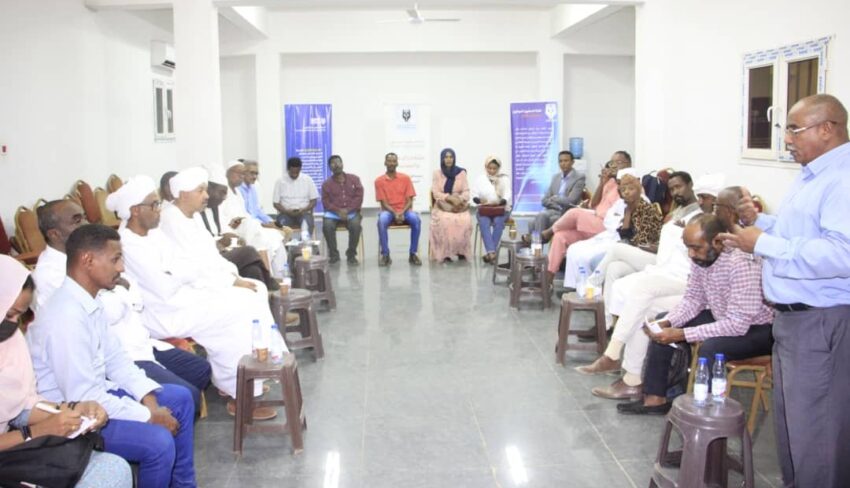
The Sudan Journalists Syndicate meets in Khartoum to discuss the security situation on April 14, 2023, one day before the outbreak of war. “Conflict has created a divide between journalists and their pens and papers,” journalist Ali Farsab told Asharq Al Awsat. “A considerable number have sought refuge outside the country via air, sea, and land routes. Meanwhile, those who remain face substantial risks, dwelling just moments away from the specter of death.” (Credit: Sudanese Journalists Syndicate)
Journalists Struggle in Underreported Sudan War
“When fighting erupted in Sudan on April 15 of last year, local journalists quickly ran into difficulties reporting on the conflict roiling their country,” the Committee to Protect Journalists said Friday.
“As the Sudanese Armed Forces (SAF) and the Rapid Support Forces (RSF) – former allies who jointly seized power in a 2021 coup – engaged in street battles, journalists were assaulted, arrested, or even killed. Others found themselves stuck at home in cities and towns under siege or unable to report due to communications blackouts. Many journalists fled, resurrecting shuttered newsrooms abroad.
“Yet one year into the war that has killed 14,000 people and displaced millions, journalists continue their struggle to cover its devastating impact.”
“Here are the top challenges to journalism in Sudan:
“Journalists have been killed, injured, and harassed
At least two journalists have been killed in the war. . . . Other journalists have been injured. CPJ has documented multiple incidents of the RSF beating and harassing local journalists. The SAF also beat a journalist, Mohamed Othman, early in the war. . . .
“Journalists are being detained by the paramilitary
“On April 15, 2023, the RSF raided and seized control of the state television headquarters in Omdurman, stopping the broadcast and trapping journalists and media workers inside for weeks. The RSF continued to use the building for military operations and as a detention facility for 11 months until March 12, when the SAF seized it in a significant advance against the RSF. . . .
“We have not forgotten the transformation the people of Sudan were leading, or the cost of the senseless war that began one year ago,” declared Secretary of State Antony J. Blinken. “The United States is working tirelessly to alleviate suffering, end the war, and put the future back into the hands of the people of Sudan.” (Credit: YouTube)
“Communications blackouts have impeded reporting
“Telecommunications and internet services have been regularly interrupted over the past year, as fighting in major cities led to the destruction of mobile towers, repeated power outages, and fuel shortages. Between February and March, the country was in an almost total blackout, isolating Sudan from the rest of the world.
“The interruptions have severely impeded the work of the press, who have had to access the internet through the Starlink satellite internet system founded by billionaire entrepreneur Elon Musk. RSF rents devices at high prices, according to news reports, and one journalist, Ataf Mohamed, raised concerns in an interview with CPJ that the RSF is able to track journalists who use the internet via Starlink. . . .
“Journalists and media outlets have relocated
“The Sudan war has displaced millions of people, including many journalists who fled hostile conditions. CPJ’s Journalist Assistance Program, which provides support to frontline members of the press, has provided a window into the scale of the problem. At least 100 Sudanese journalists have applied for support, including those who have already fled the country and those trying to flee.
“Female journalists face gender-based violence
“Since the war started, rights groups have documented a significant rise in conflict-related sexual violence against women and girls. Female journalists living in Sudan are not exempt from this danger. . . . “
- Asharq Al-Awsat, London: War Leaves 90% of Sudanese Journalists Unemployed (Dec. 15)
- Dabanga: Sudan Media Forum launches #StandWithSudan campaign to address famine and human rights abuses (April 8)
- Manal Fatima, Atlantic Council: A diplomatic solution in Sudan demands greater US engagement with its Arab allies (April 10)
- Aidan Lewis, Reuters: Why is Sudan still at war a year on?
- Samy Magdy, Associated Press: World paid little attention to Sudan’s war for a year. Now aid groups warn of mass death from hunger (April 14)
- Hawa Rahma, New Humanitarian: A Sudanese journalist describes the horrors of a war she cannot cover (Feb. 20)
- Ishaan Tharoor, Washington Post: Sudan marks grim anniversary of civil war in shadow of other conflicts (April 15)
- Linda Thomas-Greenfield, New York Times: The Unforgivable Silence on Sudan (March 18)
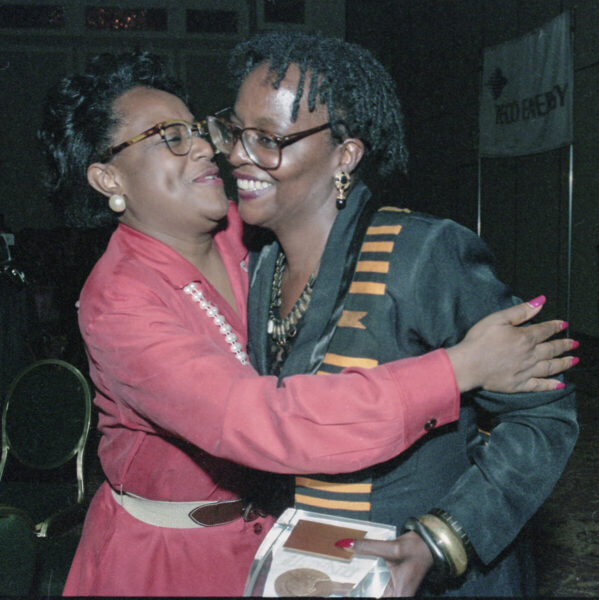
Pat Tobin, left, co-founder of the National Black Public Relations Society, congratulates Andrea Ford on becoming the National Association of Black Journalists’ “Journalist of the Year” at its 1995 convention in Philadelphia. NABJ created the Patricia L. Tobin Media Professional Award after Tobin’s death in 2008. (Photos by Jason Miccolo Johnson)
Andrea Ford Fought to Stay on the O.J. Story
Something was missing in the wealth of stories about the O.J. Simpson case and its impact, thought Vanessa Williams, veteran journalist and president of the National Association of Black Journalists from 1997 to 1999. Those were the years immediately after Simpson was found liable in a civil trial for the deaths of his ex-wife, Nicole Brown Simpson, and her friend, Ron Goldman.
“Given that O.J. Simpson’s death was a big story last week, this is a little late,” Williams wrote Tuesday on the NABJ Facebook page. “But I would still ask us to remember our dear friend and colleague, Andrea Ford, who as a local reporter at the L.A. Times fought to stay on that story after it became a national story.
“She refused to be elbowed aside. Andrea’s coverage of the trial, along with her frequent appearances on cable television to talk about it, made her a trusted expert on what was dubbed ‘the trial of the century.’ Andrea won numerous awards for her work, including being named NABJ’s Journalist of the Year in 1995.
“She also was a former NABJ board member, representing the West Coast. Andrea was a fierce, feisty advocate, challenging the news industry to show real progress, not just make empty promises, to hire, develop and promote Black journalists, and insisting on accuracy and complexity in its coverage of Black communities. She made the newsrooms she worked in and NABJ better. Our dear sister died in 1999.”
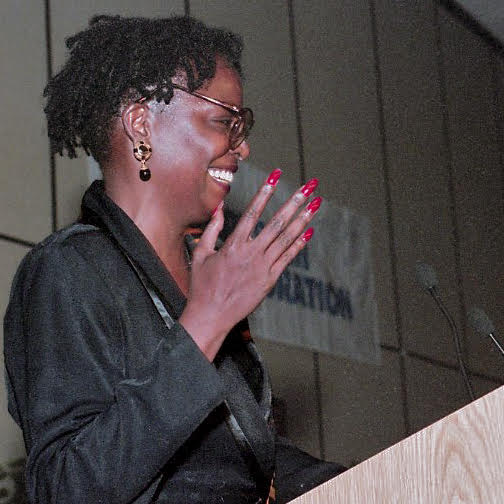 In her Los Angeles Times obituary, Edward J. Boyer wrote that Ford, (pictured) who was 49, also won a Times Editorial Award in 1995 for her work on the team covering the Simpson trial. “Ford was an outspoken advocate of ethnic diversity in newsrooms and frequently challenged her colleagues and editors to develop better approaches to covering minority communities,” he wrote.
In her Los Angeles Times obituary, Edward J. Boyer wrote that Ford, (pictured) who was 49, also won a Times Editorial Award in 1995 for her work on the team covering the Simpson trial. “Ford was an outspoken advocate of ethnic diversity in newsrooms and frequently challenged her colleagues and editors to develop better approaches to covering minority communities,” he wrote.
“ ‘Andrea was passionate about her work and her beliefs,’ said Leo Wolinsky, Times managing editor for news. ‘She was able to provide readers with a unique perspective, particularly in the urban areas where she concentrated. She was never afraid to express her point of view, even when it was not popular.’ ”
Ford inspired other journalists. One wrote in 2005, “My lasting memory of her will be at the LA convention [of NABJ in 1990] when she told a bunch of us about calling the LATimes to task about discrepancies in minority coverage. She described a newsroomwide meeting when she and some staffers openly and vocally challenged the coverage, and how one by one the nonminority reporters and editors offered their assent. The managers, thus confronted, agreed to make changes. So moved, I stuck the forks in the [name of city] newsroom, and a couple others I’ve worked in.
“To this day, sometimes when other black staffers grouse silently, I think of Andrea when I speak up. I understand others have to decide when to pick their battles, but it gets lonely sometimes… and I may have lost out on some promotions and other perks along the way, but I feel her presence and it gives me strength. That’s when I get my groove back! 🙂 God bless you, Andrea.”
- Dan Abrams, Mediaite: ‘The Deaths of Two Totally Innocent People Helped Make My Career’: Dan Abrams Opens Up About ‘Guilt’ from O.J. Simpson Trial (April 11)
- Joel Anderson, Slate: The Key Detail Missing From the Narrative About O.J. and Race
- Graham Lee Brewer and Aaron Morrison, Associated Press: In death, 3 decades after his trial verdict, O.J. Simpson still reflects America’s racial divides
- Cary Clack, San Antonio Express-News: How my perception of O.J. Simpson’s acquittal changed with time
- J.R. Gamble, the Shadow League: O.J. Simpson’s Life Was A Referendum On Race, Class and Privilege | From College Campuses to Wall Street, Everyone Was Invested In The Trial Of The Century
- Leonard Greene, Daily News, New York: O.J. Simpson ex-teammate says trial showed ‘Black man can buy justice like a white man’
- Wil Haygood, Washington Post: O.J. Simpson, capturing the camera’s attention, in high times and low (April 11)
- Jemele Hill, the Atlantic: The O.J. Verdict Reconsidered
- Erik Horne, William C. Rhoden, Jason Reid and Martenzie Johnson, Andscape: Andscape roundtable: O.J. Simpson’s death and place in culture (April 11)
- Roy S. Johnson, al.com: White folks loved them some O.J. Simpson, until they hated him
- Solomon Jones, Philadelphia Inquirer: In death, O.J. Simpson once again lays bare America’s racial fault lines (April 11)
- Michael Lee, Washington Post: ‘I’m not Black; I’m O.J.’: Why Simpson avoided athlete activism
- William Rhoden, Andscape: O.J. Simpson has a legacy we’re still trying to digest (April 11)
- Eugene Robinson, Washington Post: O.J. Simpson was always on the run (April 18)
- Dustin J. Seiber, The Root: O.J. Simpson’s ‘Trial of the Century’ Put Black People Against White People—And We Won. But at What Cost?
- Erika D. Smith, Los Angeles Times: O.J. Simpson, race and justice. It’s the debate that won’t go away (April 11)
A “mini-doc” from Reporters Without Borders, “Covering the war from Gaza: journalists who survived testify for RSF,” the group’s French acronym, is made from meetings with some of the evacuated journalists from Gaza to Doha. Wael al-Dahdouh, Agence France Press photojournalist Mahmoud Hams, RSF correspondent Ola al-Zaanoon, and her son, freelance reporter Moussa al-Zaanoon describe the risks they ran to keep reporting the news as Gaza continued to be completely closed. (Credit: YouTube)
Journalists Hit in Gaza Refugee Camp, Hospital
“Israeli forces surrounded and attacked the Nuseirat refugee camp in central Gaza on Friday, wounding several journalists and at least one other person,” Mohammad Al-Sawalhi in Gaza, and CNN’s Abeer Salman, Kareem Khadder and Zeena Saifi in Jerusalem reported Friday for CNN.
Separately, the Committee to Protect Journalists called the previous day for an independent investigation into the Israeli attack on Al-Aqsa Martyrs Hospital, also in Gaza, that injured at least eight journalists on assignment.
“On Sunday, March 31, around 11:30 a.m., an Israeli strike hit a tent encampment outside of Al-Aqsa Martyrs Hospital in Deir al-Balah, in central Gaza,” CPJ said. “The attack killed four people and injured 17 others, including eight journalists, according to several media reports, Palestinian press freedom group MADA, and four sources who spoke to CPJ, including two of the injured journalists, another who witnessed the attack, and one who went to the site afterward. The explosion, which witnesses and media reports said was caused by a drone strike, occurred outside the hospital near a journalists’ tent provided by the Turkish Anadolu news agency. . . .”
Reporting on the attack on the refugee camp, CNN continued, “Turkish state broadcaster TRT accused Israeli tanks of launching a ‘targeted attack’ on the journalists, including TRT Arabi cameraman Sami Shehada, who lost a leg, and correspondent Sami Barhoum, who suffered minor injuries. CNN stringer Mohammad Al-Sawalhi was also among those hurt.
“The TRT statement called the assault ‘a deliberate attack against media professionals, marked clearly with ‘PRESS’ on their jackets” and said it was ‘part of a broader pattern of violence’ against journalists in Gaza. As of Friday, at least 95 media workers have been killed covering the war, according to preliminary figures from the Committee to Protect Journalists.
“CNN video shows Shehada’s right leg was severed.
“ ‘We were filming in a safe place, I was wearing my flak jacket and my helmet — even the car I was in had a ‘PRESS’ and ‘TV’ sign marked on it. It was clear that I was a civilian and a journalist. We were targeted,’ he told CNN from his operating bed.
“ ‘It will not stop me from working, even if I have to walk on crutches. I will show the whole world the crimes of the Israeli occupation against civilians, people and journalists. I am one of them and I will not leave my camera even if I die,’ he told Al-Sawalhi. . . .”
- Alexandra Bruell, Wall Street Journal: New York Times Ends Probe Into Leak Over Gaza Coverage Without Conclusive Finding (April 15)
- Committee to Protect Journalists: CPJ condemns expulsion of journalist Farid Alilat on arrival at Algiers airport (April 15)
- LZ Granderson, Los Angeles Times: Netanyahu owes the U.S. better answers about Gaza (April 6)
- Meg Kelly, Hajar Harb, Louisa Loveluck, Miriam Berger and Cate Brown, Washington Post: Palestinian paramedics said Israel gave them safe passage to save a 6-year-old girl in Gaza. They were all killed.
- Kelly McBride, NPR: The relentless focus on Gaza
- Reporters Without Borders: More than 100 journalists killed in six months in Gaza – where is the international community?
- Reporters Without Borders: Justice must be rendered for Lebanese reporter killed by targeted Israeli shelling of journalists six months ago
- Cleve R. Wootson Jr., Washington Post: Biden’s handling of Gaza shakes his support in the Black community
Haitian Journalists Want Protection Under Any Deal
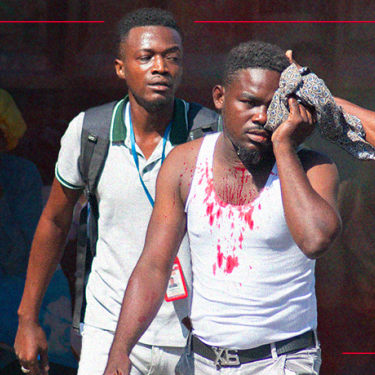 “More than 90 Haitian journalists and Reporters Without Borders (RSF) call on the international community and Haiti’s new Transitional Presidential Council to give the right to information a central place in the search for a solution to the crisis that has been intensifying in Haiti in recent months,” Reporters Without Borders said Tuesday.
“More than 90 Haitian journalists and Reporters Without Borders (RSF) call on the international community and Haiti’s new Transitional Presidential Council to give the right to information a central place in the search for a solution to the crisis that has been intensifying in Haiti in recent months,” Reporters Without Borders said Tuesday.
“As the right to information is an essential resource, Haiti’s journalists and news media must be protected so that the country does not become an information desert, RSF and Haitian journalists say in a joint appeal issued on 16 April.
“Media personnel have been directly impacted by both an unprecedented wave of gang violence and a social, economic and political crisis that has been growing since last December.
“Six Haitian journalists have been killed in connection with their work since 2022. Reporters are constantly exposed to threats, attacks or abduction. The mounting violence is carried out with complete impunity in the absence of the rule of law. As criminal gangs extend their control over the capital, Port-au-Prince, journalists are restricted to a few neighbourhoods where they can still work, albeit not without risks. Many have fled the country.
“Most of the journalists who have signed the appeal to the international community and the Transitional Presidential Council are based in Port-au-Prince or adjoining municipalities. Some work for national media outlets such as Le Nouvelliste, Haïti24 and AlterPresse. Others are freelancers. They work for print media, online media, TV and radio. Many of them belong to the Association of Haitian Journalists (AJH). Together, and with RSF, they are sounding the alarm. . . .”
- Tom Phillips and Etienne Côté-Paluck, the Guardian: ‘The city is a jail’: Haitian journalists get word out about gang violence
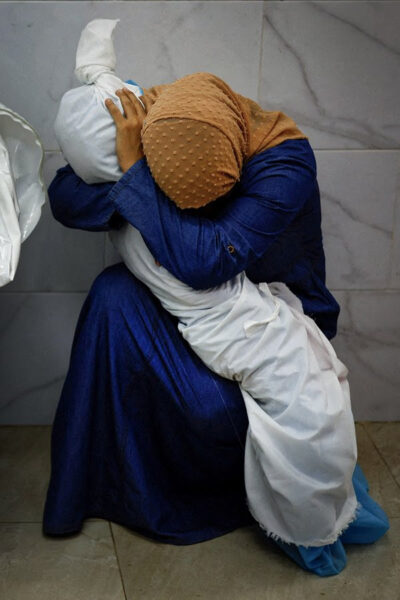
Palestinian Photographer Takes ‘Photo of the Year’
“A harrowing photograph showing a woman in Gaza sobbing in a morgue as she cradles the body of her 5-year-old niece won the 2024 World Press Photo of the Year Award on Thursday,” Dan Ladden-Hall reported for the Daily Beast.
“Mohammed Salem, a 39-year-old Palestinian Reuters photographer, captured the image at Nasser hospital in Khan Younis in the south of the enclave on Oct. 17, 2023. The picture shows Inas Abu Maamar, 36, embracing the shrouded corpse of her niece, Saly. . . .”
Honors for Story of the Year went to Lee-Ann Olwage of South Africa, for “Valim-babena” for GEO. Valim-babena is a Malagasy term that refers to children’s duty to care for their parents.
“This story tackles a universal health issue,” dementia, “through the lens of family and care,” write the contest judges,” Ellen Wexler reported for Smithsonian. “The selection of images are composed with warmth and tenderness, reminding viewers of the love and closeness necessary in a time of war and aggression worldwide. The story of Valim-babena brings to light a crucial sociological perspective that challenges the cross-cultural isolation of the elderly, instead portraying them with dignity and care.”
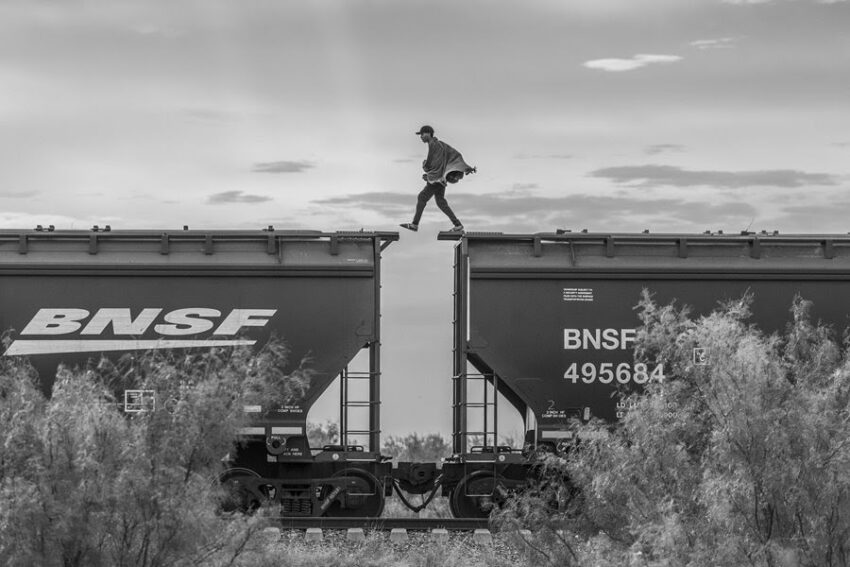
Photographer Alejandro Cegarra migrated from Venezuela to Mexico in 2017. About a year later, he started photographing migrant communities for a project called The Two Walls.
The Long-Term Project Award went to Alejandro Cegarra of Venezuela for “The Two Walls,” The New York Times/Bloomberg.
The Open Format Award went to Julia Kochetova of Ukraine for “War Is Personal.“
“While daily news media updates its audience with statistics and maps and international attention drifts elsewhere, the daily experience of Ukrainians living through the war is hard to comprehend for people outside the country,” the organization said.
“This web-based project brings together photojournalism with the documentary style of a personal diary to show the world what it is like to live with war as an everyday reality.
World Press Photo Foundation is an independent, non-profit organization based in Amsterdam, Netherlands. “Through our programs, we encourage diverse accounts of the world that present stories with different perspectives. We showcase those stories to a worldwide audience, educate the profession and the public on their making, and encourage debate on their meaning,” it says.
“The 24 winners, six honorable mentions, and two jury special mentions were selected by an independent jury out of 61,062 entries by 3,851 photographers from 130 countries,” the organization added. “In bringing together such important stories, the selection encourages greater understanding and awareness of current events, as well as serves as a reminder of the need for press freedom in all corners of the world.”
- Charlotte Cans with Amy Goodman, “Democracy Now”: U.N. Photo Collection Shows Gaza War Through the Lens of Palestinian Journalists
- Ahmed Zakot with Amy Goodman, “Democracy Now!”: “Fear and Terror”: Gaza Photographer Ahmed Zakot on Documenting the Carnage of Israel’s Assault
Short Takes
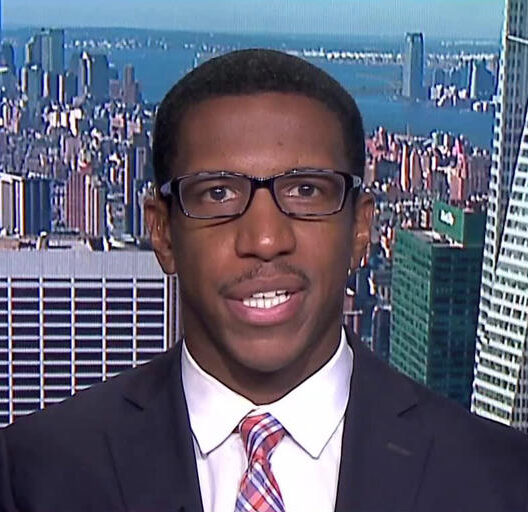 Wall Street Journal reporter Dion Rabouin (pictured), who became news himself last year when he was handcuffed and detained shortly after conducting interviews outside of a Chase Bank in Phoenix, was among those laid off by the publication, he wrote on LinkedIn April 12. “And honestly, I’m so happy and grateful. I love that I got to work at the Wall Street Journal. I got to write front-page news stories, host a podcast, create a Youtube channel and make a rap video. For the Wall Street Journal. I’m literally the only person in history who can say I did all those things,” Rabouin wrote. Covering the financial world apparently was a good fit. “Last year, I made around $20,000 on interest and dividends. That doesn’t even include the appreciation in the value of the assets I own. Literally 10 years ago, I didn’t even make $20,000 of taxable income. That’s what investing can do.” Chris Roush wrote for Talking Biz News, “He has interviewed sitting presidents from around the world as well as dozens of central bank governors and finance ministers.” In 2022, Rabouin posted about the racism he experienced working at Axios.
Wall Street Journal reporter Dion Rabouin (pictured), who became news himself last year when he was handcuffed and detained shortly after conducting interviews outside of a Chase Bank in Phoenix, was among those laid off by the publication, he wrote on LinkedIn April 12. “And honestly, I’m so happy and grateful. I love that I got to work at the Wall Street Journal. I got to write front-page news stories, host a podcast, create a Youtube channel and make a rap video. For the Wall Street Journal. I’m literally the only person in history who can say I did all those things,” Rabouin wrote. Covering the financial world apparently was a good fit. “Last year, I made around $20,000 on interest and dividends. That doesn’t even include the appreciation in the value of the assets I own. Literally 10 years ago, I didn’t even make $20,000 of taxable income. That’s what investing can do.” Chris Roush wrote for Talking Biz News, “He has interviewed sitting presidents from around the world as well as dozens of central bank governors and finance ministers.” In 2022, Rabouin posted about the racism he experienced working at Axios.
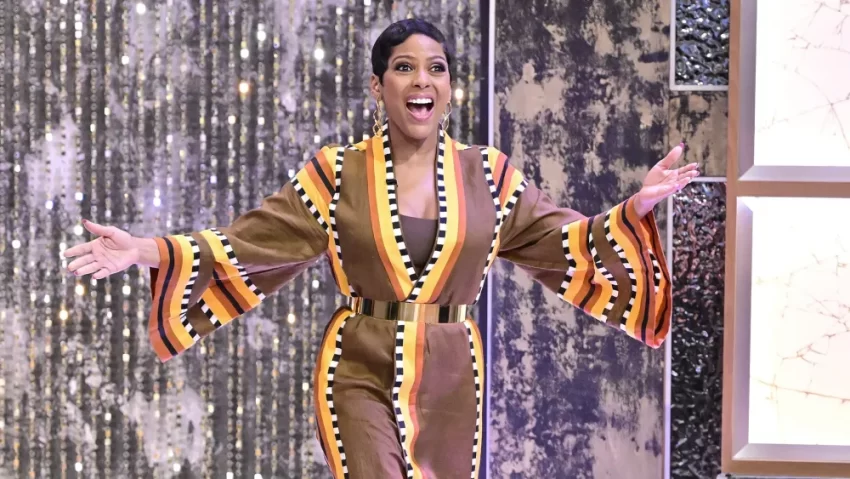
- “Today’s episode of ABC‘s Tamron Hall show was scotched after a grease fire in an on-set kitchen caused a brief evacuation of the Upper West Side ABC studio where Hall tapes the show,” Greg Evans reported April 10 for Deadline. “A rerun of the Monday eclipse episode was aired instead, but in a brief live appearance . . . ahead of the episode Hall stood on the empty, mostly evacuated set and explained what happened. . . .” Meanwhile, the show has been renewed for a sixth season. (Photo credit: Disney)
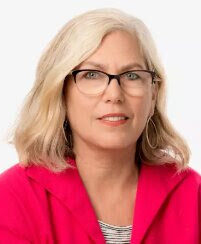 Mariel Garza (pictured) has been promoted to editorial editor at the Los Angeles Times, leading the editorial board, and Susan Brenneman is now op-ed editor, “leading the team producing the Op-Ed, Sunday Opinion and Books & Ideas pages,” Terry Tang, the former editorial editor who is now executive editor, announced April 11. Garza, who is half-Mexican on her father’s side, according to LATV, has been deputy editorial page editor since 2021.
Mariel Garza (pictured) has been promoted to editorial editor at the Los Angeles Times, leading the editorial board, and Susan Brenneman is now op-ed editor, “leading the team producing the Op-Ed, Sunday Opinion and Books & Ideas pages,” Terry Tang, the former editorial editor who is now executive editor, announced April 11. Garza, who is half-Mexican on her father’s side, according to LATV, has been deputy editorial page editor since 2021.
- The South Florida chapters of the National Association of Black Journalists and the National Association of Hispanic Journalists are partnering on a career fair Saturday, April 20, to be held from 8 a.m. to 2 p.m. at Broward College-Miramar Campus (1930 SW 145th Ave, Miramar, Fla. 33027).
- “LGBTQIA+ representation in TV content boosts viewership among young (18-34) Americans, according to a new report from Horowitz Research,” James Careless reported Wednesday for TV Technology. “The company’s ‘State of Media, Entertainment, and Tech: FOCUS LGBTQIA+’ report found that one in three (33%) of 18-34 year-olds surveyed are more likely to watch a show with LGBTQIA+ characters and stories in it. In addition, two in three (66%) LGBTQIA+ viewers are more likely to watch a show that is inclusive of LGBTQIA+ characters, along with features/stories that focus on their culture and communities. . . .”
- The Freedom Forum is turning over the Chips Quinn Program for Diversity in Journalism, launched in 1991 with the mission to diversify the industry’s workforce pipeline, to the nonprofit Journalism Funding Partners, the organizations announced Monday. “Freedom Forum will support the transition of this program for the next three years, providing a $10,000 per person stipend to 10 journalists selected by JFP each year,” they said. “Since 2020, the Chips Quinn program has been enlisting mentors from its pool of more than 1,400 alumni and pairing them with interns working in various Gannett newsrooms across the country. Now, JFP is working to expand on this pilot project to include early career journalists from more news organizations beginning summer 2024. . . .”
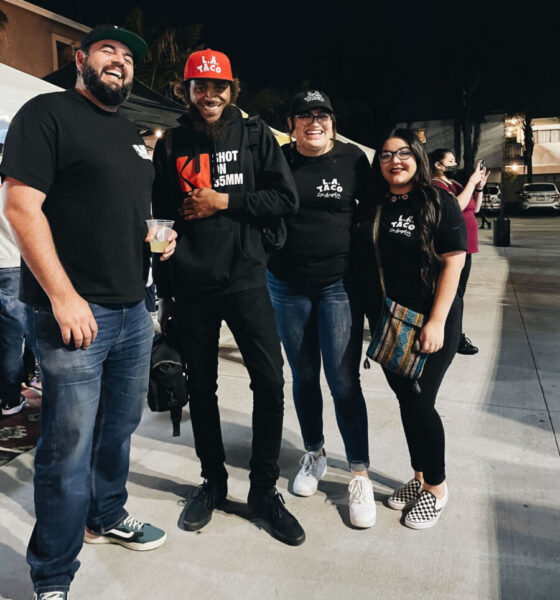
- “Yesterday, we made the tough decision to furlough our tiny team — Hadley Tomicki, Memo Torres, Lexis-Olivier Ray, and Janette Villafana — until further notice, effective this Monday,” Javier Cabral wrote April 11 for LA Taco. The publication “centers food coverage while covering working class communities across Southern California,” in the words of Gustavo Arellano, Los Angeles Times columnist. “After Sunday, we do not have enough money to make another payroll. How did we get here? We entered 2024 with a lot of hope, but were unable to grow our membership program to a substantial amount or re-sign our largest advertiser in time. . . .” Arellano told his readers Tuesday, “L.A.’s heartbreak industry isn’t Hollywood; it’s journalism. To paraphrase what the late A. Bartlett Giamatti said about baseball, it’s designed to break the hearts of those who work it. . . .”
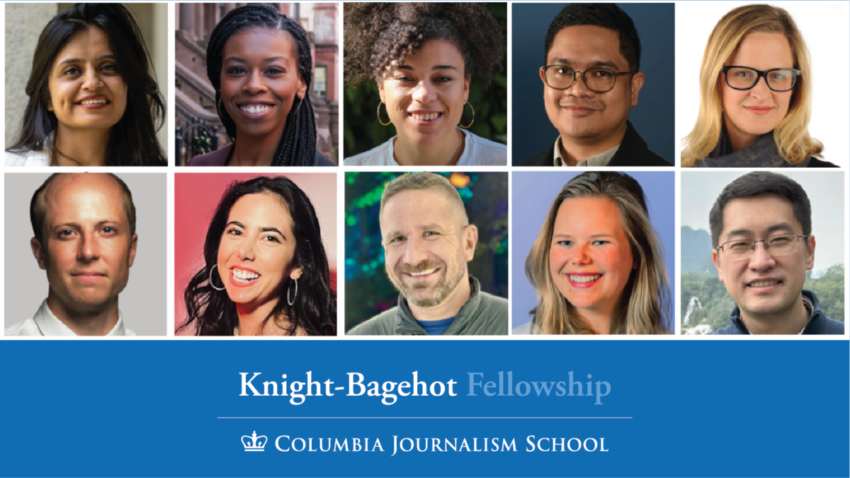
- Columbia Journalism School has announced 10 Knight-Bagehot Fellows in Economics and Business Journalism for the 2024-2025 academic year. Among them: Varsha Bansal, “an independent reporter and editor from India writing at the intersection of technology, AI, labor and human rights”; Brittany Jones-Cooper, “a reporter and producer who has worked at CBS, ABC and CNBC Select,” where she’s a contributor on “Today”; Olivia Konotey-Ahulu, the United Kingdom’s equality reporter for Bloomberg News; Ralf Rivas, business reporter and desk editor at Rappler; and Erchi Zhang, deputy director of Caixin’s TMT News Desk, based in Shanghai.
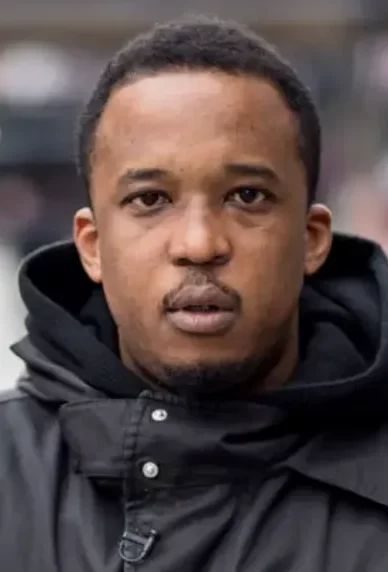 D. Watkins (pictured), an editor at large for Salon and a writer on the HBO limited series “We Own This City,” is to receive the 2023 Vernon Jarrett Medal for Journalistic Excellence Friday from Morgan State University’s School of Global Journalism and Communication. Watkins will also receive a check for $10,000 and be assigned a fall intern from the school to work with. Separately, the school has released the spring issue of its Morgan Global Journalism Review, with the cover story, “Black Expats: Stress Free in Panama and Paris.”
D. Watkins (pictured), an editor at large for Salon and a writer on the HBO limited series “We Own This City,” is to receive the 2023 Vernon Jarrett Medal for Journalistic Excellence Friday from Morgan State University’s School of Global Journalism and Communication. Watkins will also receive a check for $10,000 and be assigned a fall intern from the school to work with. Separately, the school has released the spring issue of its Morgan Global Journalism Review, with the cover story, “Black Expats: Stress Free in Panama and Paris.”
- “A bill partially inspired by the New Voices movement to protect the rights of student journalists has passed both the Minnesota Senate and House, and it now heads to a conference committee to work out differences between the two versions unrelated to student media,” the Student Press Law Center reported April 12. “SF 3567 would, among other things, ensure that Minnesota’s public sixth through 12th grade student journalists determine the content of student media and cannot be censored except in certain rare circumstances. Yearbooks, however, are excluded from such protections. The legislation also prohibits school administrators from retaliating against student media advisers who refuse to unlawfully restrict their students’ rights. . . .”

- Editor & Publisher (E&P) Magazine is launching a free-to-access content vertical, “Public Pulse,” Publisher Mike Blinder announced Thursday. It will be “dedicated to providing executive insights on public media. The online platform, available at EditorandPublisher.com/PublicMedia, aims to address the informational needs of public media executives navigating a rapidly evolving media landscape.” Blinder also said, “We spent most of 2023 assessing the state of public media through editorial reporting and interviews with executives managing local public media operations across the US. We recognize that these key executives have been underserved in accessing essential information to continue building audience and revenue.” Already in this space is Current, founded in 1980 as “a nonprofit news organization covering public media in the U.S for professionals in the industry,” which is “sustained by subscriptions, advertising and individual donations.”
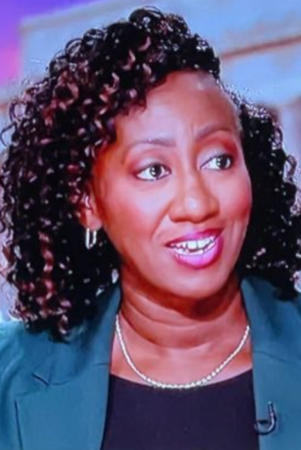 “Bloomberg News has hired Amara Omeokwe (pictured) to cover the Federal Reserve Board and the economy,” Chris Roush reported April 12 for Talking Biz News. “She was a Wall Street Journal economics reporter before being laid off earlier this year. Before joining the Journal in 2019, she was at “Morning Edition,” NPR’s flagship morning program. . . .”
“Bloomberg News has hired Amara Omeokwe (pictured) to cover the Federal Reserve Board and the economy,” Chris Roush reported April 12 for Talking Biz News. “She was a Wall Street Journal economics reporter before being laid off earlier this year. Before joining the Journal in 2019, she was at “Morning Edition,” NPR’s flagship morning program. . . .”
- I
 Indira Lakshmanan (pictured) has joined the U.S. News & World Report “to start an Ideas & Opinions platform,” U.S. News announced April 3. “In this newly created role, Lakshmanan will be responsible for developing and overseeing content that provides perspective, insight and thought leadership around current issues and events. An award-winning editor, columnist and correspondent in Washington, D.C. for the last 16 years, Lakshmanan’s career has taken her to more than 80 countries across six continents, where she has reported for print, digital and broadcast media. . . .”
Indira Lakshmanan (pictured) has joined the U.S. News & World Report “to start an Ideas & Opinions platform,” U.S. News announced April 3. “In this newly created role, Lakshmanan will be responsible for developing and overseeing content that provides perspective, insight and thought leadership around current issues and events. An award-winning editor, columnist and correspondent in Washington, D.C. for the last 16 years, Lakshmanan’s career has taken her to more than 80 countries across six continents, where she has reported for print, digital and broadcast media. . . .”
- “MediaCo Holding, which owns radio stations WQHT (Hot 97) and WBLS in New York, said it acquired Estrella Media’s Spanish-language video, audio and digital content operations,” Jon Lafayette reported Thursday for Broadcasting & Cable. “MediaCo said former Telemundo executive Jacqueline Hernández was named interim CEO and will run the company with its new assets, which include the Estrella TV network, free ad-supported streaming television (FAST) channels Estrella TV, Estrella News, Cine Estrella TV and Estrella Games plus the Estrella TV app. . . .”
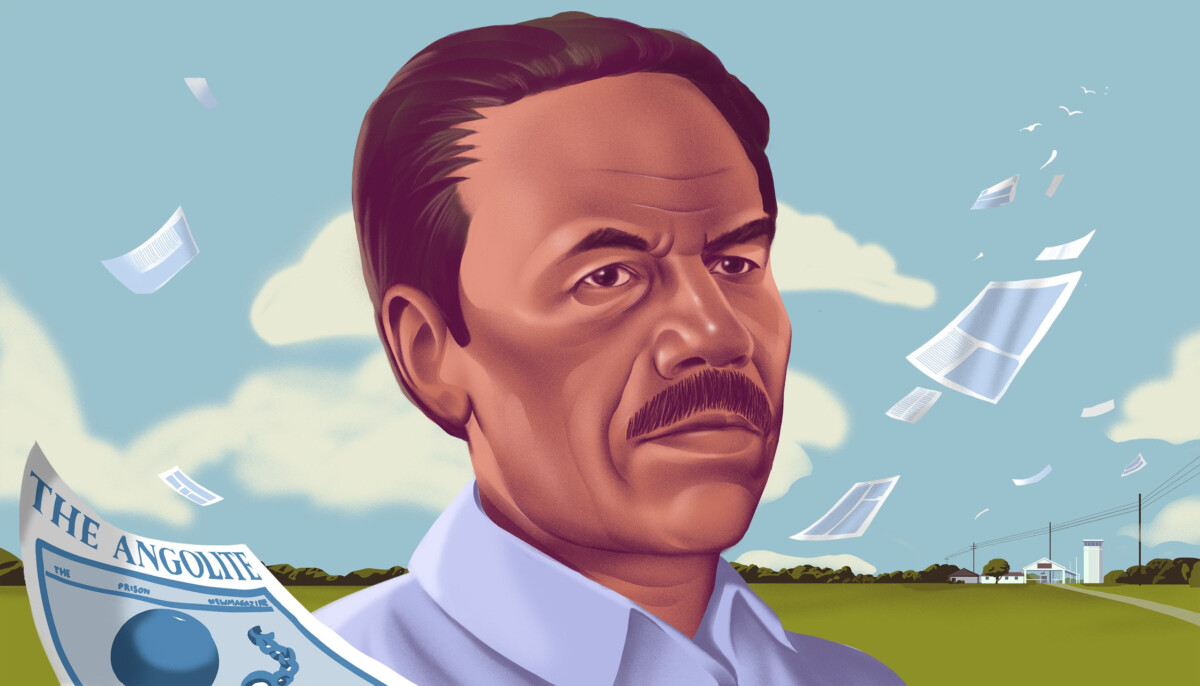 “Wilbert Rideau’s (depicted) extraordinary life as a tribune,” the Marshall Project summarized Monday. “Sentenced to death in Louisiana, Rideau launched a career as a prison journalist, fearlessly publishing stories about life on the inside that drew an international audience. He was released in 2005 after serving decades behind bars. Here, John J. Lennon, another accomplished prison writer and [Marshall Project] contributor, interviews Rideau, a George Polk Award career laureate. How did Rideau learn the narrative skills he used as editor? ‘I sat in a cell for 12 years, reading. There was no school for me to go to,’ he tells Lennon.”
“Wilbert Rideau’s (depicted) extraordinary life as a tribune,” the Marshall Project summarized Monday. “Sentenced to death in Louisiana, Rideau launched a career as a prison journalist, fearlessly publishing stories about life on the inside that drew an international audience. He was released in 2005 after serving decades behind bars. Here, John J. Lennon, another accomplished prison writer and [Marshall Project] contributor, interviews Rideau, a George Polk Award career laureate. How did Rideau learn the narrative skills he used as editor? ‘I sat in a cell for 12 years, reading. There was no school for me to go to,’ he tells Lennon.”
- “Katie Couric called out her former Today co-anchor, Bryant Gumbel, over his alleged ‘sexist attitude’ about her maternity leave from the NBC morning show,” Armando Tinoco reported Tuesday for Deadline. “In a new interview, Couric opened up about her time on Today and claimed the journalist was not supportive when she took time off to give birth to her first child. . . . “
- “In response to the sharp decline in press freedom in India, Reporters Without Borders (RSF) calls on political parties fielding candidates in the general elections beginning April 19 to commit to ten concrete measures that aim to defend the right to reliable news and information and protect journalists,” the press freedom organization said April 12. RSF added Thursday, “Nearly half of the 28 journalists killed in India since Narendra Modi took over as prime minister ten years ago, including media directors, investigative reporters and correspondents, were working on stories linked to the environment. Protecting journalists and combatting impunity for crimes of violence against them should [be] at the centre of the elections in which Modi is seeking another term.”
- The Committee to Protect Journalists welcomed South African President Cyril Ramaphosa’s “signing into law a bill that abolishes criminal defamation, and urged authorities to reform other problematic laws that threaten press freedom in the country, the group said April 10. “South Africa becomes the latest country in southern Africa to decriminalize defamation, following its neighbors Zimbabwe (2016) and Lesotho (2018). Other countries in the Southern African Development Community regional bloc which continue to use criminal defamation against journalists include Angola and the Democratic Republic of the Congo, according to CPJ research. . . .”
- “The Committee to Protect Journalists urged Mali’s media regulator to lift its ban on political reporting in the country and allow journalists to cover the news without restrictions,” CPJ said April 11. That day, “the country’s High Authority for Communication (HAC) issued a directive that ‘invited all media’ to ‘stop all broadcasting and publication’ of coverage on political parties and activities of a political nature of associations, according to the HAC press release and news reports. The HAC’s directive follows a decree from Mali’s transitional government, which took power in a 2021 military coup.”
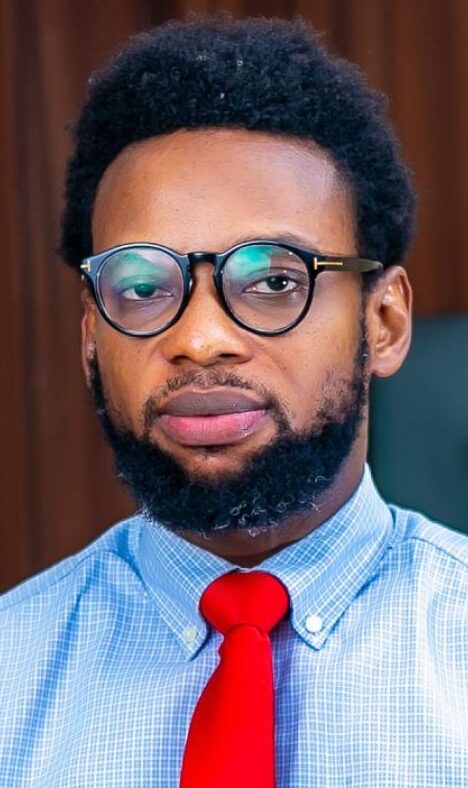 “Nigerian authorities should immediately drop their investigation into the Foundation for Investigative Journalism (FIJ) and its founder, the award-winning undercover reporter, Fisayo Soyombo (pictured), and stop intimidating the chairperson of FIJ’s board of trustees, Bukky Shonibare,” the Committee to Protect Journalists said Tuesday. “On February 21, Soyombo published an investigation detailing how he had smuggled rice into Nigeria with the collusion of Nigeria Customs Service (NCS) officials and accused local businessman Ibrahim Dende Egungbohun of being a smuggler. FIJ’s accompanying documentary was also broadcast by Arise News.” More on Fisayo Soyombo
“Nigerian authorities should immediately drop their investigation into the Foundation for Investigative Journalism (FIJ) and its founder, the award-winning undercover reporter, Fisayo Soyombo (pictured), and stop intimidating the chairperson of FIJ’s board of trustees, Bukky Shonibare,” the Committee to Protect Journalists said Tuesday. “On February 21, Soyombo published an investigation detailing how he had smuggled rice into Nigeria with the collusion of Nigeria Customs Service (NCS) officials and accused local businessman Ibrahim Dende Egungbohun of being a smuggler. FIJ’s accompanying documentary was also broadcast by Arise News.” More on Fisayo Soyombo
- “Togolese authorities must identify and hold accountable the law enforcement agents responsible for arresting and assaulting French journalist Thomas Dietrich and ensure both foreign and local journalists are able to freely report on political news,” the Committee to Protect Journalists said on Wednesday. “On Tuesday, a court in Togo’s capital Lomé sentenced Dietrich, a freelance reporter, to a six-month suspended prison sentence for illegal entry and banned him from Togolese territory. He was then taken to the country’s Benin border and expelled, according to the journalist. . . .” Separately, on April 10, CPJ welcomed the release of journalist and La Dépêche publishing director Apollinaire Mewenemesse and called for Togolese authorities “to lift the conditions placed on his freedom, drop all charges against him, and cease criminalizing journalism. . . .Mewenemesse was arrested on March 26 and charged on March 28 with spreading false news and various anti-state charges in connection to a February 28 La Dépêche report that questioned the findings in a murder trial of an army officer. . .”
- “A representative of Reporters Without Borders (RSF) has been deported from Hong Kong on arrival to the territory to monitor the landmark trial of publisher Jimmy Lai, who faces the rest of his life behind bars on spurious national security charges,” the press freedom group said April 10. “This action by the Hong Kong authorities, unprecedented for RSF, marks a new decline in the already poor press freedom climate in the territory. . . .”
To subscribe at no cost, please send an email to journal-isms+subscribe@groups.io and say who you are.
Facebook users: “Like” “Richard Prince’s Journal-isms” on Facebook.
Follow Richard Prince on Twitter @princeeditor
Richard Prince’s Journal-isms originates from Washington. It began in print before most of us knew what the internet was, and it would like to be referred to as a “column.” Any views expressed in the column are those of the person or organization quoted and not those of any other entity. Send tips, comments and concerns to Richard Prince at journal-isms+owner@
View previous columns (after Feb. 13, 2016).
View previous columns (before Feb. 13, 2016)
- Diversity’s Greatest Hits, 2018 (Jan. 4, 2019)
- Book Notes: Is Taking a Knee Really All That? (Dec. 20, 2018)
- Book Notes: Challenging ’45’ and Proudly Telling the Story (Dec. 18, 2018)
- Book Notes: Get Down With the Legends! (Dec. 11, 2018)
- Journalist Richard Prince w/Joe Madison (Sirius XM, April 18, 2018) (podcast)
- Richard Prince (journalist) (Wikipedia entry)
- February 2018 Podcast: Richard “Dick” Prince on the need for newsroom diversity (Gabriel Greschler, Student Press Law Center, Feb. 26, 2018)
- An advocate for diversity in the media is still pressing for representation, (Courtland Milloy, Washington Post, Nov. 28, 2017)
- Morgan Global Journalism Review: Journal-isms Journeys On (Aug. 31, 2017)
- Journal-isms’ Richard Prince Wants Your Ideas (FishbowlDC, Feb. 26, 2016)
- Richard Prince with Charlayne Hunter-Gault, “PBS NewsHour,” “What stagnant diversity means for America’s newsrooms” (Dec. 15, 2015)
- Book Notes: Journalists Follow Their Passions
- Book Notes: Journalists Who Rocked Their World
- Book Notes: Hands Up! Read This!
- Book Notes: New Cosby Bio Looks Like a Best-Seller
- Journo-diversity advocate turns attention to Ezra Klein project (Erik Wemple, Washington Post, March 5, 2014)

